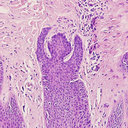The efficacy and tolerability of long-term cabergoline therapy in hyperprolactinaemic disorders: an open, uncontrolled, multicentre study. European Multicentre Cabergoline Study Group.
الكلمات الدالة
نبذة مختصرة
OBJECTIVE
We assessed the efficacy and safety of the new, long-acting dopamine agonist drug cabergoline during long-term therapy of hyperprolactinaemia.
METHODS
Open, prospective, multicentre study.
METHODS
One hundred and sixty-two females with either a microprolactinoma (n = 100), idiopathic hyperprolactinaemia (n = 54), empty sella syndrome (n = 7) or residual hyperprolactinaemia after surgery for a macroprolactinoma (n = 1). All had previously been treated with cabergoline or placebo for 4 weeks as part of a dose-finding study.
METHODS
Menstrual pattern, adverse symptoms, blood pressure and pulse, serum PRL, blood count, liver and renal function were assessed after one month and subsequently at two-monthly intervals.
RESULTS
Treatment was started at doses of 0.25 mg (n = 3), 0.5 mg (n = 8), 1 mg (n = 150) or 2 mg (n = 1) per week, given either as a single weekly dose (n = 8) or divided into twice-weekly doses (n = 154), and was continued for at least 49 weeks in 123 patients. Final treatment doses ranged from 0.25 mg fortnightly to 2 mg twice weekly: most patients finished the study taking 0.5 mg once (n = 31) or twice (n = 77) weekly. Stable normalization of PRL levels was achieved in 138 subjects (85%), in 129 of whom the effective dose was < 1 mg per week. In the subset of 114 patients completing 49 weeks of therapy and having dose adjustments according to the protocol, the biochemical success rate was 92%. Fifty-nine of the 65 previously amenorrhoeic women (91%) and 44 of the 49 (90%) who were previously oligomenorrhoeic resumed regular menses and/or became pregnant during the study. Adverse events were reported in 64 patients (39.5%). In 84% of cases with adverse events, the symptoms were of mild or moderate severity and most occurred during the first few weeks of therapy; five patients (3%) discontinued treatment because of poor tolerance. The most frequent symptoms were dizziness (13% of patients), headache (13%), nausea (10%) and weakness and/or fatigue (10%). Of 27 patients who had previously been poorly tolerant of other dopamine agonists, 17 (63%) did not experience any side-effects and only one was intolerant of cabergoline. No adverse haematological or biochemical effects were detected except for a slight downward trend in haemoglobin which may have been related to the resumption of regular menses in previously amenorrhoeic or oligomenorrhoeic women. A mild hypotensive effect was observed, mean systolic and diastolic blood pressures falling by 5 and 4 mmHg respectively during treatment.
CONCLUSIONS
The results provide evidence for the long-term effectiveness and safety of cabergoline in the treatment of hyperprolactinaemia. Its ability to normalize PRL and restore gonadal function compares favourably with reported data on reference compounds while its tolerability profile and simple administration schedule offer potential advantages in terms of patient acceptability.


